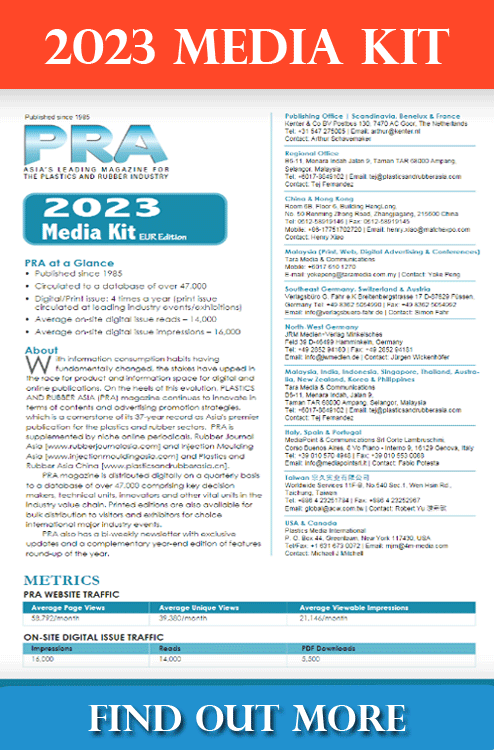Recycling: PureCycle to build PP recycling plant in Europe; Asahi Kasei develops recycling technology for extraction of carbon fibre from CFRTPs

PureCycle Technologies and Port of Antwerp-Bruges say that PureCycle will build its first polypropylene (PP) recycling facility in Europe in the port’s fast-growing NextGen District.
The new plant will have a capacity of 59,000 tonnes/year, with opportunities to expand operations in the future since the 14-ha plot can support up to four processing lines with a total capacity of 240,000 tonnes/year.
PureCycle is currently engaged in feedstock sourcing and financial planning with the intent to secure a final project timeline by mid-2023. Construction of the plant will begin upon completion of the permitting process, currently anticipated in 2024.
NextGen District is a global hub for businesses seeking to advance the circular economy. The district is located at the Port of Antwerp-Bruges, Europe’s second largest port. PureCycle was recently awarded a concessionaire contract during NextGen’s competitive bid selection process.
PureCycle is already in active negotiations with potential feedstock and offtake partners and expects to commence commercial operations at its new European facility when construction of the first processing line is completed. The new PP purification plant will not only supply the European market with PureCycle’s UPR resin but is also expected to create 65-70 new jobs for local residents during the initial phase of the project. This project represents one of the largest investments announced in the NextGen District to date. Various funding options are currently being considered, including traditional financing sources as well as grants/subsidies for circular projects that are uniquely available in the EU.
With the company’s flagship recycling plant in Ironton, Ohio expected to start pellet production in Q1 of 2023; a second plant in Augusta, Georgia under initial construction; and its first PP recycling plant in Asia currently on track to open in 2025, PureCycle is expanding globally and actively scaling its production capabilities

Meanwhile, chemicals firm Asahi Kasei says it has developed a new technology for recycling carbon fibre plastic compounds together with the National Institute of Technology, Kitakyushu College and Tokyo University of Science.
Carbon fibre-reinforced plastics (CFRP) are highly attractive for various industries in demanding application fields due to their unique balance of rigidity, mechanical strength and light weight – also compared with conventional glass fibre-reinforced plastics. However, CFRPs are expensive and challenging from a recycling perspective, as it is difficult to extract the carbon fibres from the resin after usage.
Together with its project partners at the National Institute of Technology at Kitakyushu College and the Tokyo University of Science, Asahi Kasei has developed a recycling method that allows carbon fibres to be extracted from CFRP or carbon fibre-reinforced thermoplastics (CFRTP) used in automobiles. This results in high-quality, inexpensive continuous carbon fibre that can be recycled perpetually, contributing to circular economy. Unlike carbon fibre that is chopped up during the recycling process, Asahi Kasei’s method allows carbon fibre to be extracted from a plastic compound seamlessly, resulting in continuous strands of carbon fibre that can be reapplied in exactly the same manner while retaining properties identical to the original substance.
The conventional technologies for recycling carbon fibres by chopping and re-applying them results in a product with lower quality and less durability, insufficient for high-performance applications. To address this issue, Asahi Kasei has developed an “electrolysed sulphuric acid solution method” that allows the carbon fibre to retain its original strength and continuous nature while fully decomposing the resin the carbon fibre is embedded in.
This allows for its continued use in high-performance applications and presents an inexpensive, circular solution to the end-of-life dilemma of carbon fibre plastic compounds. Thus, these compounds present in vehicles for weight reduction. It can be easily and inexpensively be broken down at end-of-vehicle-life and reapplied to new vehicles in the future.
In addition, Asahi Kasei is developing a carbon fibre-reinforced thermoplastic unidirectional tape (CFRTP-UD tape) that utilises both recycled continuous carbon fibre and the company’s Leona polyamide resin. Boasting a higher strength than metal, this CFRTP-UD tape can be applied to automobile frames and bodies, further enabling the recycling of end-of-vehicle-life parts into different, new automobile parts. This presents a solution to the long-term challenge that carbon fibre usage for vehicles has posed on the industry and is expected to economically benefit and strengthen carbon fibre’s usage within the automobile industry on a global scale.
Moving forward, Asahi Kasei will perform demonstrations and develop the business, aiming for practical application around 2030.
(IMA)Subscribe to Get the Latest Updates from IMA Please click here
©2023 Injection Moulding Asia. All rights reserved.


















